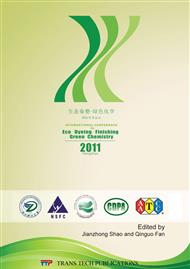p.741
p.746
p.750
p.754
p.759
p.764
p.767
p.772
p.777
Extraction of Bamboo Nanofibers Using Acid Hydrolysis for Functional Chemicals of Ecological Dyeing and Finishing
Abstract:
In this work a study on the feasibility of extracting cellulose nanofibers from bamboo fibers, by means of three different procedures was carried out. These processes included the using of three different types of acids (H2SO4, HCl, and a mixture of H2SO4/HCl). The raw bamboo fibers were mercerized with NaOH solutions. They were then submitted to the three different acid hydrolysis processes. The final bamboo nanofibers were morphologically characterized by transmission electron microscopy (TEM) and their surface charges in suspensions were estimated by Zeta-potential. Their degree of polymerization (DP) was characterized by viscometry and the crystallinity was tested by X-ray diffraction (XRD). All bamboo nanofibers presented a rod-like shape, an average diameter (D) of 6-10 nm and length (L) of 100-180 nm, with an aspect ratio (L/D) of around 16-18. The aggregation state increases with the amount of HCl introduced into the extraction, due to the decrease of surface charges. However, this release presented nanofibers with litter better degree of polymerization than those whose acid hydrolysis was carried out using only H2SO4.
Info:
Periodical:
Pages:
759-763
Citation:
Online since:
January 2012
Authors:
Keywords:
Price:
Сopyright:
© 2012 Trans Tech Publications Ltd. All Rights Reserved
Share:
Citation:


